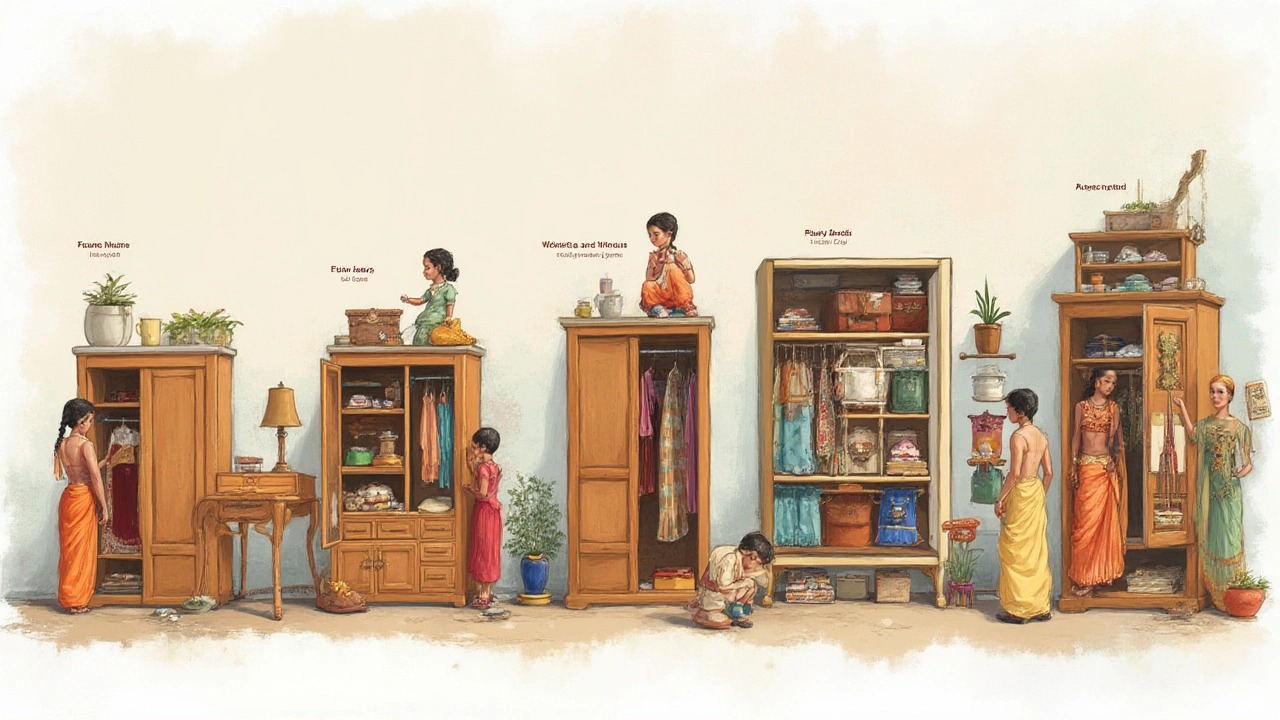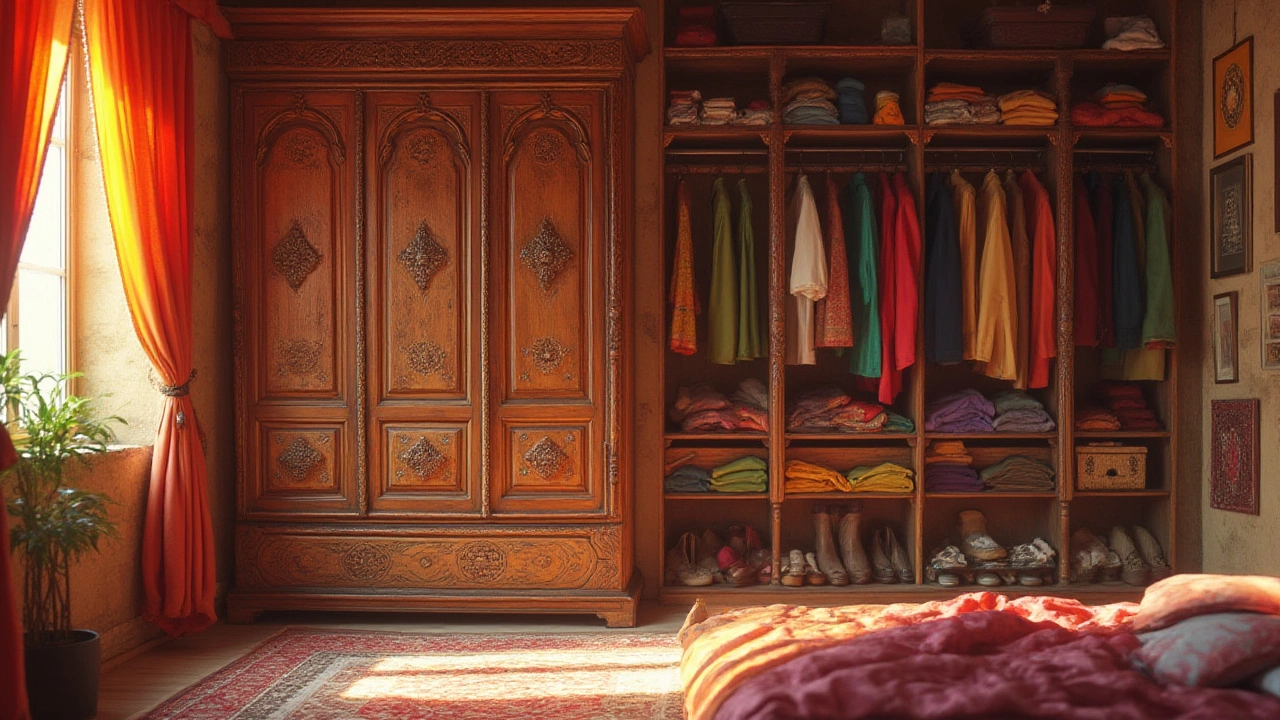Imagine getting dressed on a chilly Melbourne morning. You swing open a wide, elegant wooden wardrobe, its doors creaking with a kind of historic charm, and pick your favorite jumper. You might wonder: isn’t this just a closet by another name? That’s where things get interesting. The debate about wardrobes and closets isn’t just a test of vocabulary—it’s really about how people around the world organise their homes, what feels familiar, and what actually works best for storing all that stuff we collect.
What Is the Difference Between a Wardrobe and a Closet?
Wardrobes and closets both serve the same basic role: they hide away your clothes, shoes, and often all the other bits of life you’d rather keep out of sight. But these two words aren’t quite interchangeable, and if you’ve ever browsed furniture in Australia or the UK, then shopped for a bedroom in the US, you’ll know the terms come with a few surprises.
A wardrobe is a free-standing piece of furniture. It stands alone—literally. Think of a tall, armoured cabinet, sometimes ornately carved, other times sleek and minimal. You find them sitting against a wall or tucked into a corner, ready to be shifted around if you decide to rearrange your layout. Wardrobes often include a rail for hanging clothes, shelves for jumpers, and sometimes drawers underneath for socks or underwear.
On the other hand, the term "closet" usually means a built-in space. A closet is part of your house—typically a small room or a recessed cavity built into a wall, fitted with doors or sliding panels. In older Aussie homes, closets aren’t always there; plenty of houses built before the 1970s in Melbourne, for instance, only had wardrobes. Closets sometimes have simple rods, custom shelving, shoe racks, and all sorts of organizing gadgets that can be added later. They take on a huge range of forms, from small linen closets to expansive walk-in setups that are more room than storage furniture.
The big takeaway? While both hold clothes, a wardrobe is furniture you can move around or sell on Facebook Marketplace; a closet is a built-in part of your home. Many folks, especially in Europe and Australia, have grown up calling their free-standing storage a wardrobe. Americans are more likely to use the word closet, and might not see a wardrobe unless they visit an old hotel or a historical house.
It’s not just language. There’s a practical difference, too. Wardrobes offer more flexibility—switch flats, move the wardrobe. Want to update your style? Swap your old one for a new one without any renovations. Closets, though, tend to offer more storage spread—especially if customized. Ever seen those US reality shows with a closet styled for 100 pairs of shoes? That’s closet culture at its peak.
The History and Evolution of Wardrobes and Closets
Here’s a cool fact: the first wardrobes weren’t even for clothes. In 17th century France, the word "wardrobe" actually meant a room to store armor and weaponry. The English borrowed the concept, and by the Victorian era, wardrobes and armoires were status symbols, loaded with decorative details.
Early Australian homes, following British design, had no built-in storage. Wardrobes travelled with families, passed down generations. If you stroll Melbourne’s vintage markets, you might spot an old cedar or walnut wardrobe—beautiful, solid, and sometimes with hidden compartments from the days before closets were standard. In fact, some families took such prized wardrobes with them when moving across Australia’s massive distances, unlike a closet, which, of course, stays put.
The American closet became popular in the mid-20th century, tied to suburban housing booms and changing lifestyles. More space, more stuff, a need to hide it away—closets filled that demand. In the 21st century, built-ins became part of every home plan in the country, and walk-in closets started appearing in higher-end properties globally. Meanwhile, the wardrobe, though still loved in Europe and Australia, became rarer in new builds where design trends favoured minimal lines and empty walls.
| Storage Solution | Typical Location | Period Popularized | Pros | Cons |
|---|---|---|---|---|
| Wardrobe | Bedroom, movable | 17th Century - Present | Portable, quick to set up, no need for renovation | Can take up space, less capacity than walk-ins |
| Closet | Built-in, fixed to wall | 1950s on (mainstream) | Customizable, uses awkward spaces, often larger | Not movable, renovation required to upgrade |
Melbourne, for all its trends, still loves a timber wardrobe. But you’ll notice more apartments incorporating sliding-door built-in closets, often shallow but stretching wall-to-wall, taking notes from the US concept.

Why Choose One Over the Other? Pros, Cons, and Tips
Let’s break down some practical reasons to choose a wardrobe or a closet for your next storage solution—because space, style, and even your rental agreement might make the choice for you.
Wardrobe lovers rave about the easy swap factor. Renting? You can move it in or out when your lease changes. You get total freedom with style, whether you prefer a Scandinavian minimalist look or something antique and unique. Wardrobes are also pretty handy for shifting storage needs—a growing kid’s room, a spare guest space, or an ad-hoc linen spot. The flat-pack wardrobe industry is booming for a reason: it fits in almost any room and price range.
On the other hand, closets just eat up less visual space. Built-ins hide behind simple panels, making bedrooms feel bigger and less cluttered. You can go wild organizing a closet—just hit up IKEA or Bunnings for hanging racks, hooks, modular shelves, even dedicated tie or jewelry drawers. Big families or fashion lovers usually appreciate the extra room. Custom closets let you squeeze every nook for storage, important if you’re tight on square meterage.
- Tips for wardrobe buyers: Measure your room and the wardrobe itself. Mind those apartment stairs—moving a massive wardrobe up two flights isn’t fun.
- Choose finishes that fit your space and durability needs. Painted MDF looks great but scratches easily; solid wood costs more, but will outlast you.
- If you’re worried about mould (hello, Melbourne’s damp winters), choose wardrobes with a bit of air flow at the back, or line the inside with moisture absorbers.
- A tall wardrobe with mirrored doors can double as a dressing spot and visually open your room up.
- Tips for closet users or renovators: If you’re building or updating, go custom if you can. That way, you’ll maximize your space.
- Look for pull-out baskets or rails to avoid losing things in the dark corners. LED strip lighting in a closet is a game changer, especially during Melbourne’s early winter mornings.
- Try adjustable shelves. Your storage needs will change, but the closet won’t unless you give it some flex.
- Don’t forget doors—sliding panels are clever for tight rooms. Open shelves can make the space feel bigger, but only if you’re pretty tidy.
If you’re in a share house or moving heaps, wardrobes win. If you own your place and want to add value later, closet upgrades are a sure bet—real estate agents always talk up good built-ins at house viewings.
The Final Word: Which Should You Call It and Does It Really Matter?
Here’s the punchline: Most people use "wardrobe" and "closet" to mean the same thing, especially if you grew up switching between British and American shows (or have an Aussie passport and a streaming account). But if you’re shopping, planning renovations, or fielding a question about “Where’s the closet?” from visitors, it pays to know the fine print.
The word "wardrobe" doesn’t just cover that free-standing triple-door behemoth your Nan kept. It’s become shorthand for the whole concept of clothes storage—both in conversation and in showroom tags. But in property listings, architects, and people with opinions about home design (that’s almost everyone at a dinner party), wardrobe means moveable, closet means built-in. Check if your rental says “built-in robes”—that’s a closet, just local-speak. If in doubt, ask or take a quick look yourself.
In big cities like Melbourne, new apartments often have shallow built-in robes that could barely hide your winter coats, and you’ll spot homes in the outer suburbs still shipping in classic timber wardrobes from vintage shops. So what counts as a closet, and when does a wardrobe count as a closet? For storage furniture brands, the answer changes depending on where they’re selling. For your own home, the really important thing is how well your storage deals with daily chaos—whether you call it a wardrobe or a closet.
Last stat: a 2024 Australian home organization survey found nearly 38% of respondents kept both a wardrobe and a closet in their main bedroom. Why? Because you can never have enough space in Melbourne for puffer jackets, umbrellas, or costume-party disasters. If you’re debating what to buy or build next, figure out what works for you. That way, you don’t just win the storage game—you nail your style, budget, and sanity too.

